
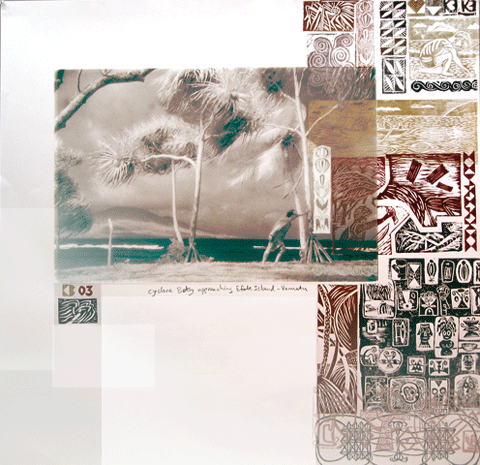
Cyclone Betsy Approaching Efate Island Vanuatu, Vanuatu Series
block printing over photograph on paper, 64cm x 89cm
Venues:
Aterial Gallery Adelaide, 2003
Cornstalk Cafe Thirroul, 2004
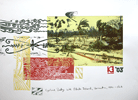
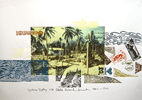
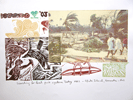

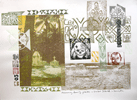
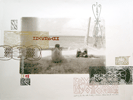
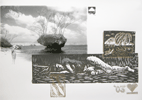










Cornstalk Cafe Thirroul
This exhibition grew out of a trip to Vanuatu. On new Year's eve 1991 Kurt Brereton travelled to Vanuatu for a month long romantic holiday with his new partner Sarah Lambert. Staying in a remote part of Efate Island they were hit by cyclone Betsy, one of worst in living memory.
A large number of villages were wiped out and people were homeless, hungry and in need of support.Kurt and Sarah's hut on the beach was destroyed and they just managed to escape to higher ground through waist deep rising waters. Kurt took a number of disaster photographs for the local villagers to help secure compensation and relief from various international aid agencies.
Some ten years later in 2003 Brereton was asked to have an exhibition of photos, drawings and paintings from this trip. Using these images Brereton chose instead to use these images as raw material for larger works employing a combination of photos and linocut stamp prints.
Counter-Signs of Difference (catalog essay)
Anecdotally, the Vanuatu series is a loose biographical tracing of a honeymoon holiday lashed by cyclone Betsy in the summer of 1992. Each work symbolically anchors the mundane or dramatic events of each day of a month long holiday on Efate Island. Titles such as “Fair Star Vision No 2 – Lost on the Banyan Tree Walk” play with tourist mythologies of time measured in hourly stop overs, rushed market crawls and whirl wind mystery tours.
Brereton and his partner Sarah Lambert decided to fly to Vanuatu on a whim, set free at the completion of the academic year. Knowing virtually nothing (except Club Med style TV ads) about the culture, history or politics of this Pacific group of islands, the young couple flew into a Kava and Fosters fuelled New Year’s Eve party of rage-like proportions. Beneath the Gauguin’s romantic idyll images of languid life beneath palms and beside pink sand beaches, there surged a society and culture of complex interwoven counter points and oftenviolent clashes. The arrival of cyclone Betsy at the end of the month stay instantly stamped itself into their existence as a symbol for a series of events and things that fell beyond their control and yet indelibly impacted upon them on a number of fronts. The destruction of villages, food crops and coral reefs, arrival of deceases (the mysteriously named “cyclone sickness”) and desperate calls for aid to various sponsor Churches in beyond the horizon, all served to rip apart the cosy scenario of their Lonely Planet guide fantasy.
On a more mundane personal level for the artist tourist on a month long holiday, the cyclone marks the end of bachelor life and beginning of family commitments. As such, the photographs of a decade ago take on a nostalgic dream-like patina of indeterminacy. Ten years later these images served as perfect starting mimetic points for a revision and re-examination of the broader and deeper signs of cultural difference that kept resurfacing (as punctums) in the artist’s mind as involuntary memories.
These signs included the ni-vanuatu sand drawings or “ground writings” , Missionary gravesites, and Christian religious iconography, tourist products and market handcrafts. The intertwining, lacing, knotting and labyrinthine tracings found in both ni-vanuatu and Western European Celtic missionary iconographic languages, formed an uncanny nexus (egocentric) starting point for Brereton’s own graphic interpretations and commentaries in linocut form. The hand carved technique of linocut lent itself to the inevitable fragmentary tourist narrative of the Pacific holiday. Overlaying the historic photos of yesteryear with monoprints of today presented a series of analogical desiring machines (as in Deleuze and Guattari – flows of energy, circulations and interruptions) that could libidinally produce what Alphonso Lingus refers to as “polyvocal conjunctions”. The often tragic and sometimes comic colonial and post-colonial history of Vanuatu can be metonymically and emblematically found embedded in the trope of the knot. From continuous line sand-drawings of Ambrym Island to the Celtic crosses of C19th Catholic missionaries. From the finely plaited pandanus grass wedding dresses of Ambrae Island to the beautifully evolved “Old Mother Hubbard” – the legacy of Presbyterian Scottish missionary dresses.
These counter signs of difference weld together new and unique heterogeneous forms and languages. The resulting sensuous geography of a thousand marked nuances is constructed out of flying sheets of corrugated roofing iron, flashing machetes and hard hats. The artist’s morphology of experiences is feed on coconut curries made from export quality lobsters, rare palm crabs and Keen’s curry powder. Against the glossy travel brochure backdrops of swaying palms and eternal swimming pools, there exists just out of camera shot a rougher harder edged reality of decease, poverty, dissolving and morphing customs – in short the common third world story of survival in the face of mono-cropped globalism and paternalistic regionalism.
From the narrow external perspective of Brereton, as an Australian tourist and in a small sense part of the problematic post-colonial flow of forces buffeting the shores of Vanuatu, any body of creative work must signal and address in a discursive sense, the difficult mix of conflicts, ironies and opportunities that exist as part of the import and export economies of the Pacific.
Yet in the face of certain despairs and endgames there exist wonderful collaborations both brief and sustained. Out of strange translations communication of desires and objectives do take place and seem to persist. The spiral and curlicue linearity of life in the Pacific is drawn out under the enormous blue vault of the sky and stretched drum-tight and measured against the oceanic curve of the horizon.
The beautiful complex logic of the sand drawing and Celtic knot alike spells out the same mystery of infinite length coupled with the pulsation and periodicity of all sea cultures that unrolls and breaks upon the island shores of Vanuatu, Ireland, Scotland or Australia.
© Kurt Brereton 2003